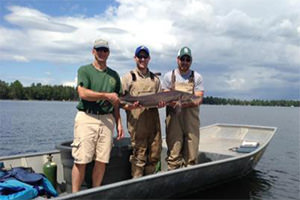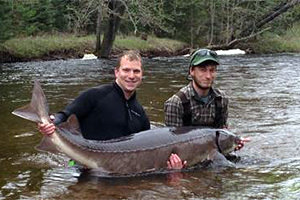2013 Sturgeon For Tomorrow Research
Summary of August 2013
Juvenile Lake Sturgeon Survey of Black Lake

From August 12-29 DNR Fisheries Division and collaborators surveyed juvenile lake sturgeon in Black Lake. The purpose of the survey was to evaluate the lake sturgeon stocking that has been underway since 2001 and to determine what level of natu-ral recruitment may be taking place. There were 283 individual lake sturgeon captured during the survey and most of the fish were juveniles. There were 5 recaptures. The smallest fish cap-tured was 22” and the largest fish was 71”. Fin ray samples and fin tissue were collected from the fish to allow for age determi-nation and genetic analysis. Data analysis is continuing and a more comprehensive report of the survey results will be avail-able soon.
Great Lakes Stewardship Initiative
On August 7, 2013 SFT president Brenda Archambo talked about Sturgeon For Tomorrow’s programs with twenty teachers from throughout Michigan. It was a beautiful, summer day on the Upper Black River. Brenda also discussed the river habitat resto-ration projects with educators as part of the Lake Huron
Stewardship Place-Based Education workshop.
Sturgeon in the Classroom
Sturgeon For Tomorrow has been collaborating with the Michi-gan DNR for the past five years in a concerted effort to offer Sturgeon in the Classroom. This exciting program places live fish in the classroom coupled with class appropriate curriculum. Eight classrooms from across the state are participating in the 2013-2014 school year. Woo-Hoo!!
2013 Lake Sturgeon Research and Stocking Summary
Netting and Tagging in the spring spawning Run
A total of 270 adult lake sturgeon were netted and tagged during spawning
| Recaptures | New | Total | |
|---|---|---|---|
| Males | 187 | 21 | 208 |
| Females | 46 | 16 | 62 |
| Total | 233 | 37 | 270 |
Larval Drift
922 larvae were collected and transferred to the sturgeon hatchery for rearing
18,500 lake sturgeon fry stocked on July 1, 2013

“Survival of the eggs and fry exceeded expectations this year,” said Dave Borgeson, Northern Lake Huron Management Unit Supervisor for the DNR’s Fisheries Division. “Because the Black River location is a small streamside facility, it is not able to accommodate the large number of fry we had on hand. Young fish were stocked in appropriate locations that help us achieve our management goals of rehabilitating lake sturgeon populations in these waters.”
- Pigeon River: 7,000
- Maple River: 4,000
- Sturgeon River: 4,000
- Otsego Lake: 3,585
- Little Traverse Bay Bands of Odawa Indians (LTBB) Fish Hatchery: 3,750
Little Traverse Bay Bands of Odawa Indians
Celebrate Fish Hatchery Ribbon Cutting on August 1
The Little Traverse Bay Bands of Odawa Indians (LTBB) opened its first state of the art fish hatchery in an unveiling ceremony which it has been planning and fundraising for since 1998. The $2.5 million facility is on an 80-acre property north of Pellston on Drier Road and will house office and lab space, as well as two large ponds capable of raising up to 40,000 finger-lings each. Select species such as walleye, lake herring, whitefish and sturgeon will be studied on the property by the Odawa Natural Resources
Department. Congratulations!
Sturgeon Hatchery Tours/Releases August 30, 2013
- 3,250 stocked in the Upper Black River
- 100 to be retained over-winter at Wolf Lake for future telemetry study
- 300 to be retained at streamside hatchery for a couple weeks for a tag retention study, then released in Burt/Mullett lakes in September.
- 60 to be retained at streamside hatchery for a couple weeks for an olfactory study involving Canadian researchers, then released in Burt/Mullett lakes in September
- Burt and Mullett Lakes: 490 fall fingerlings stocked into each lake
LTBB Released 202 sturgeon Fingerlings into Burt Lake on September 3, 2013
Other MSU Research Conducted
- Evaluation of hatchery Stand Operating Procedures
- Adult Spawning Behavior Studies
- Larval Growth and Development
- Feeding Experiments
- Home Page
- Black Lake
Sturgeon Shivaree - Black Lake Watershed
- Black Lake Sturgeon Management Plan
- Committees
- Contact Us
- Directors
- Events
- Habitat Conservation
- Membership
- Newsletters
- Our History
- Photo Gallery
- Research
- Resources
- Resources for Educators
- SFT Scholarships
- Spearing Guidelines
- State Regulations
- Sturgeon Guarding
- Sturgeon Hatchery
- Sturgeon in the Classroom

